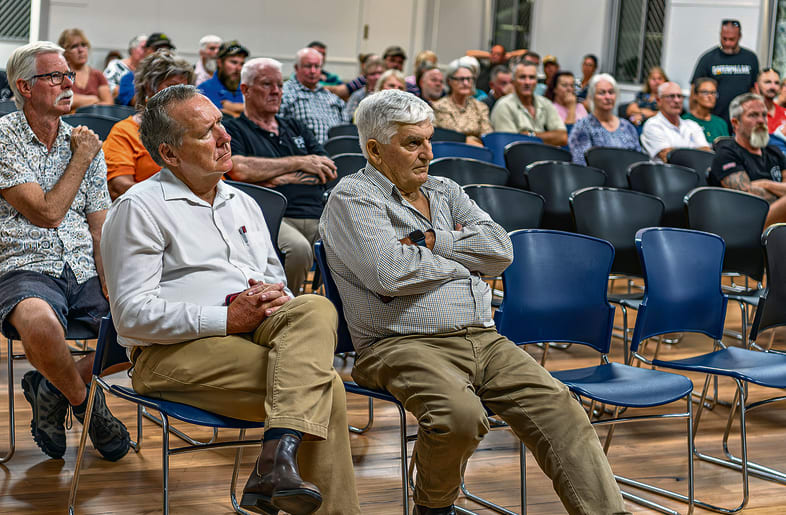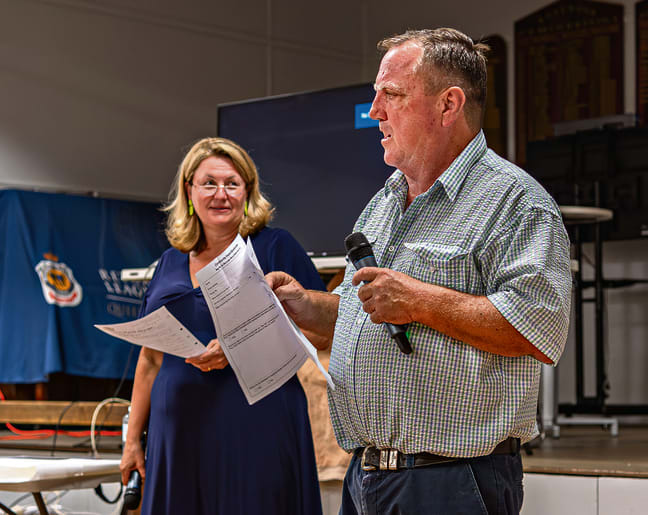
Ipswich Council Division 4 candidate Jim Madden with Scenic Rim councillor and candidate for Scenic Rim Division 6 Duncan McInnes. Photo: LYLE RADFORD

Ipswich Mayor Teresa Harding with master of ceremonies for the evening Paul Stenzel. Photo: LYLE RADFORD
TWO key figures from the national grassroots network against “reckless renewables” urge residents to ‘fight with their every breath’ plans for a solar plant at Lower Mount Walker.
National Rational Energy Group Vice-Chairwoman Katy McCallum, who is also the founder of the Kilkivan Action Group, is campaigning against the $14.2 billion Borumba Pumped Hydro which will destroy ancient forest and endangered wildlife including the Australian lungfish, platypus, Mary River turtle, koala, and wedge-tailed eagle.
Ex-cop and former Lockyer Valley resident, Ms McCallum said she has also watched in horror in recent months as Chinese company Beijing Energy International has bought up tens of thousands of acres of cattle farms for “green energy” projects around Kilkivan.
She spoke to The Fassifern Guardian as residents from Say No to the Proposed Lower Mount Walker Solar Farm group last Thursday convened their second community meeting at the Rosewood Memorial Hall.
They met to discuss Libra Energy’s proposals for a solar complex and battery plant on 231ha of prime farming land at 108 Blanchs Road.
Residents fear, if the solar facility is approved, more will follow and valuable farmland will be erased from the map.
“Australia will not be the same in 20 years’ time if these solar farms and battery energy storage systems are rolled out,” Ms McCallum said.
“We will be starved of food from our farms and there will be an extinction event in the bush.
“Solar and wind farms will ruin communities like Lower Mount Walker; agricultural land and the environment will be destroyed – it will bankrupt Australia.
“Currently, there are more than 1,000 new renewable projects in the pipeline and almost all these are in regional Australia.
“The government is exploiting the fact most projects are in or near coastal, farming, and traditional communities with small populations.
“In many cases, our right to judicial review or appeal has, or will, be removed.”
Recently, Energy Minister Chris Bowen said that “local landholders and regional communities” were “absolutely crucial to renewable energy transformation”.
“Where these projects are done well, communities benefit from more jobs, cheaper energy, better connectivity and more business opportunities,” Mr Bowen said.
But renewables critics have highlighted a raft of problems with renewable projects.
A recent study by US advisory firm Clean Energy Associates found that 25 percent of large-scale batteries have inbuilt fire risks caused by manufacturing defects.
Only last November, a Tesla lithium battery fire ripped through the Bouldercombe solar plant in Rockhampton.
Residents were warned to stay indoors and avoid toxic fumes while fire crews acted on Tesla advice to let the fire burn itself out over many days.
Meanwhile, at the helm of Property Rights Australia is Jim Willmott, an advocate for the rights of local communities.
He said Lower Mount Walker residents should fight “tooth and nail” against the Libra Energy plan because “the reckless roll out of renewables is eroding the rights of what people can do on their land”.
“A landholder might sell his land – and that’s his right – but what about the ripple effect on surrounding people; what it means for their property values, the environment, and the liveability of the area?
“There is no legal protection for the surrounding community from these types of developments, and this is happening on a national scale.”





